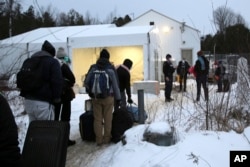Canada’s highest court is deliberating whether to overturn a nearly 20-year-old immigration agreement with the United States on the grounds that asylum-seekers cannot safely be returned to Canada’s southern neighbor.
Canadian immigration experts have argued before the Supreme Court of Canada that the Safe Third Country Agreement should be repealed because of what they describe as “unconscionable” conditions that migrants face when returned to the United States.
The agreement was signed in 2002 and went into effect in December 2004. In it, the United States and Canada agreed to turn back travelers at legal land crossings who claim asylum or refugee status in one country after having been in the other.
Janet Dench, executive director of the Canadian Council for Refugees, is one of the groups fighting the agreement in the Supreme Court.
“What the evidence shows and what we hear from people who've experienced it, as well as independent investigations of the situations, is that it is really very abusive conditions of detention, where people spend long periods in conditions that are really atrocious,” she said to VOA.
Advocates for scrapping the agreement say it violates Canada’s constitutionally guaranteed rights to “life, liberty and the security of the person” by forcing asylum-seekers back into what they describe as deplorable conditions in immigration detention facilities in the United States. They say it could also result in migrants being sent back to countries where they could be persecuted.
Asked to comment on conditions in U.S. detention centers, a U.S. Immigration and Customs Enforcement spokesperson told VOA that the agency “is firmly committed to the health and welfare of all those in its custody.”
In an emailed statement, the spokesperson said, “All people in ICE custody receive medical, dental, and mental health intake screening within 12 hours of arriving at each detention facility” and that “ICE annually spends more than $315 million on the spectrum of health care services provided to people in ICE custody.”
As of October 14, 28,067 people were being held in ICE detention centers.
US detention inspection
While U.S. officials maintain that detainees are well treated, immigration lawyers and advocates in the U.S. have for years criticized detention conditions for immigrants in the United States.
The Immigrant Defense Project and the Center for Constitutional Rights in February published a report in which five people shared their experiences in the U.S. immigration detention system. They said conditions in the detention facilities “inflict harm and break people’s spirits."
In September, federal investigators published the results of an unannounced inspection at the privately owned and operated Torrance County Detention Center in Estancia, New Mexico, where an earlier report from the Department of Homeland Security’s inspector general recommended that all of the detainees be moved to another facility because of unsatisfactory conditions. The center is typical of U.S. immigration facilities, the report’s authors said.
The Canadian side
Canadian government lawyers defended the Safe Third Country Agreement before the Supreme Court, maintaining that the agreement is constitutional and allows for exceptions in cases where refugees would face harm. They also asked that any ruling striking down the pact be suspended for a year so the government can formulate an alternative.
That makes sense to Vancouver-based immigration lawyer and policy analyst Richard Kurland, who said in an interview he believes Canada should end the agreement but there needs to be something to replace it.
The 2002 agreement was prompted “by the idea that people were trampling into Canada after failing their refugee claims [in] the United States and just bilking Canada for government proceeds,” he said. “So, the public did not like that. The political solution was to discuss that Safe Third Country Agreement.”
A peculiarity of the agreement is that it was written in such a way that it applies only at legal border crossing points. That means that asylum-seekers who sneak across the nearly 9,000-km-long border can remain in Canada to have their claims processed.
The Royal Canadian Mounted Police stopped 23,348 refugee status claimants in the first eight months of this year, a six-year high. That is 13% more than in all of 2017, when such crossings started to be counted.
Since February 2017, a total of 67,805 refugee claims were made by people crossing between border posts. Of those, 28,332 claims were accepted and 19,646 were rejected.
Jamie Liew, an associate law professor at the University of Ottawa and a practicing immigration attorney, says the recent increase in crossings may be the result of the easing of many border restrictions imposed to fight COVID-19.
“I imagined that the pandemic might have played a role given that the border was largely closed to a lot of people and the ability to move across the border was more difficult,” Liew said.
There is no indication when the Supreme Court of Canada will render a decision. At 8,891 kilometers, the U.S.-Canada border is the longest undefended international boundary in the world.














